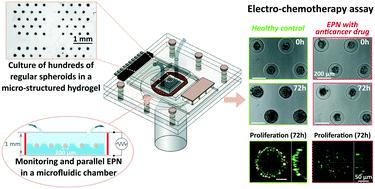Our official English website, www.x-mol.net, welcomes your
feedback! (Note: you will need to create a separate account there.)
Integrated platform for culture, observation, and parallelized electroporation of spheroids
Lab on a Chip ( IF 6.1 ) Pub Date : 2022-04-20 , DOI: 10.1039/d2lc00074a Pauline Bregigeon 1 , Charlotte Rivière 2, 3, 4 , Laure Franqueville 1 , Christian Vollaire 1 , Julien Marchalot 1 , Marie Frénéa-Robin 1
Lab on a Chip ( IF 6.1 ) Pub Date : 2022-04-20 , DOI: 10.1039/d2lc00074a Pauline Bregigeon 1 , Charlotte Rivière 2, 3, 4 , Laure Franqueville 1 , Christian Vollaire 1 , Julien Marchalot 1 , Marie Frénéa-Robin 1
Affiliation

|
Reversible electroporation is a method to introduce molecules into cells by increasing the permeability of their membranes, thanks to the application of pulsed electric fields. One of its main biomedical applications is electro-chemotherapy, where electroporation is used to deliver anticancer drugs into tumor tissues. To improve our understanding of the electroporation effect on tissues and select efficient treatments, in vitro tumor models are needed. Cell spheroids are relevant models as they can reproduce tumor microenvironment and cell–cell interactions better than 2D cell cultures. Various methods offering a relatively simple workflow are now available for their production. However, electroporation protocols usually require handling steps that may damage spheroids and result in random spacing, inducing variations in electric field distribution around spheroids and non-reproducible electroporation conditions. In addition, only a few microsystems allow the production and electroporation of spheroids, and the spheroids produced lack reproducibility in size and location. To overcome these issues, we developed a unique device enabling culture, monitoring, and electroporation of hundreds of regular spheroids in parallel, with a design ensuring that all spheroids are submitted to the same electric field conditions. It is comprised of a microfluidic chamber encompassing a micro-structured agarose gel, allowing easy medium exchange while avoiding spheroid handling. It also enables optical imaging of spheroids in situ, thanks to transparent electrodes. In this paper, we describe the fabrication and characterization of the developed microsystem and demonstrate its applicability to electroporation of a network of spheroids. We present a first successful application as an anticancer drug testing platform, by evaluating the bleomycin effect on HT29 colorectal cancer cell spheroids. This work opens new perspectives in the development of in vitro assays for the preclinical evaluation of electroporation-based treatment.
中文翻译:

球体培养、观察和并行电穿孔的集成平台
可逆电穿孔是一种通过增加细胞膜的渗透性将分子引入细胞的方法,这要归功于脉冲电场的应用。它的主要生物医学应用之一是电化学疗法,其中电穿孔用于将抗癌药物输送到肿瘤组织中。为了提高我们对电穿孔对组织的影响的理解并选择有效的治疗方法,体外需要肿瘤模型。细胞球体是相关模型,因为它们可以比 2D 细胞培养物更好地再现肿瘤微环境和细胞间相互作用。提供相对简单的工作流程的各种方法现在可用于其生产。然而,电穿孔协议通常需要处理步骤,这些步骤可能会损坏球体并导致随机间距,从而导致球体周围电场分布的变化和不可重现的电穿孔条件。此外,只有少数微系统允许生产和电穿孔球体,并且生产的球体在尺寸和位置上缺乏再现性。为了克服这些问题,我们开发了一种独特的设备,可以同时对数百个常规球体进行培养、监测和电穿孔,设计确保所有球体都处于相同的电场条件下。它由一个包含微结构琼脂糖凝胶的微流体室组成,可轻松更换培养基,同时避免球体处理。它还可以对球体进行光学成像原位,这要归功于透明电极。在本文中,我们描述了开发的微系统的制造和表征,并证明了它对球体网络电穿孔的适用性。我们通过评估博来霉素对 HT29 结直肠癌细胞球体的作用,首次成功应用作为抗癌药物测试平台。这项工作为开发基于电穿孔的治疗的临床前评估的体外测定开辟了新的前景。
更新日期:2022-04-20
中文翻译:

球体培养、观察和并行电穿孔的集成平台
可逆电穿孔是一种通过增加细胞膜的渗透性将分子引入细胞的方法,这要归功于脉冲电场的应用。它的主要生物医学应用之一是电化学疗法,其中电穿孔用于将抗癌药物输送到肿瘤组织中。为了提高我们对电穿孔对组织的影响的理解并选择有效的治疗方法,体外需要肿瘤模型。细胞球体是相关模型,因为它们可以比 2D 细胞培养物更好地再现肿瘤微环境和细胞间相互作用。提供相对简单的工作流程的各种方法现在可用于其生产。然而,电穿孔协议通常需要处理步骤,这些步骤可能会损坏球体并导致随机间距,从而导致球体周围电场分布的变化和不可重现的电穿孔条件。此外,只有少数微系统允许生产和电穿孔球体,并且生产的球体在尺寸和位置上缺乏再现性。为了克服这些问题,我们开发了一种独特的设备,可以同时对数百个常规球体进行培养、监测和电穿孔,设计确保所有球体都处于相同的电场条件下。它由一个包含微结构琼脂糖凝胶的微流体室组成,可轻松更换培养基,同时避免球体处理。它还可以对球体进行光学成像原位,这要归功于透明电极。在本文中,我们描述了开发的微系统的制造和表征,并证明了它对球体网络电穿孔的适用性。我们通过评估博来霉素对 HT29 结直肠癌细胞球体的作用,首次成功应用作为抗癌药物测试平台。这项工作为开发基于电穿孔的治疗的临床前评估的体外测定开辟了新的前景。











































 京公网安备 11010802027423号
京公网安备 11010802027423号